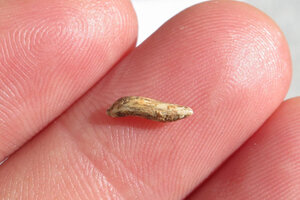Could you fight off prehistoric 20-foot lizards? Early Aborigines likely did.
A new discovery shows Australia's first human inhabitants grappled with massive predatory lizards.

Osteoderm (skin bone) of the giant monitor lizard from Colosseum Chamber at the Capricorn Caves. The giant lizard is believed to have roamed Australia during the Ice Age, along with early aborigines.
Courtesy of Gilbert Price
Australia is home to some of the world’s most dangerous wildlife creatures, and it may have always been that way.
New research shows Australia’s first human inhabitants grappled with massive predatory lizards.
Researchers working in Central Queensland discovered the first evidence ever to indicate that Australia’s early human inhabitants and giant apex predator lizards lived together during the same era, according to Gilbert Price, a vertebrate palaeoecologist at Australia's University of Queensland.
The researchers dated the bone at about 50,000 years old by using radiocarbon and uranium thorium techniques. That would coincide with the arrival of Australia’s Aboriginal inhabitants.
“Our jaws dropped when we found a tiny fossil from a giant lizard during a two [meter] deep excavation in one of the Capricorn Caves,” Dr. Price said about the find, in a university release. “The one-[centimeter] bone, an osteoderm, came from under the lizard’s skin and is the youngest record of a giant lizard on the entire continent.”
Price speculated that the bone could be from a Komodo dragon or the extinct Megalania monitor lizard, an even bigger species that weighed about 1,100 pounds and could grow nearly 20 feet long.
The Capricorn Caves, where the fossil was found, is home to millions of bones of different species and is considered one of Australia’s most fossil-rich sites.
“This study also begs the question – what else is entombed in our caves and what else can we learn?” said Capricorn Caves manager Ann Augusteyn, in the release. She added that this find shows that caring for the caves is an important responsibility.
Price said this adds a dimension to the debate over what caused their extinction: “Humans can only now be considered as potential drivers of their extinction,” whereas climate change used to be the only viable theory.
During the last Ice Age in the Pleistocene geological period, enormous lizards and 30-foot long crocodiles would roam Australia, according to Price.
Today, the perentie is the largest lizard found in Australia. It can grow up to six and half feet long.
But lethal creatures are not a thing of the past. Australian Geographic listed some of the world’s top killer species that call Australia home: venomous snakes, killer bees, box jellyfish, and poisonous spiders, just to name a few.

